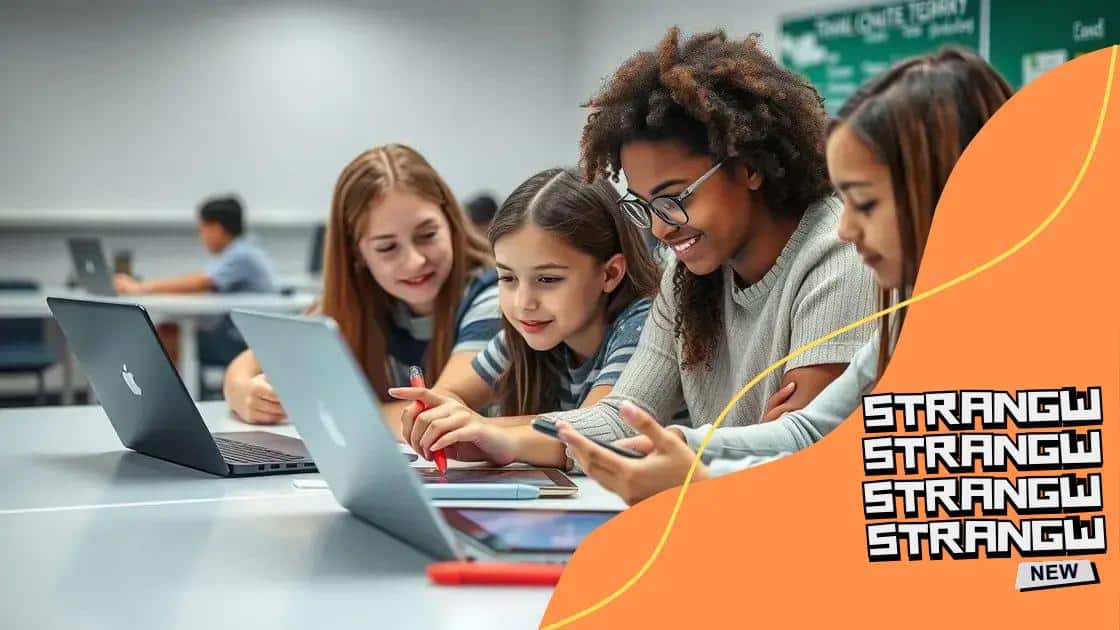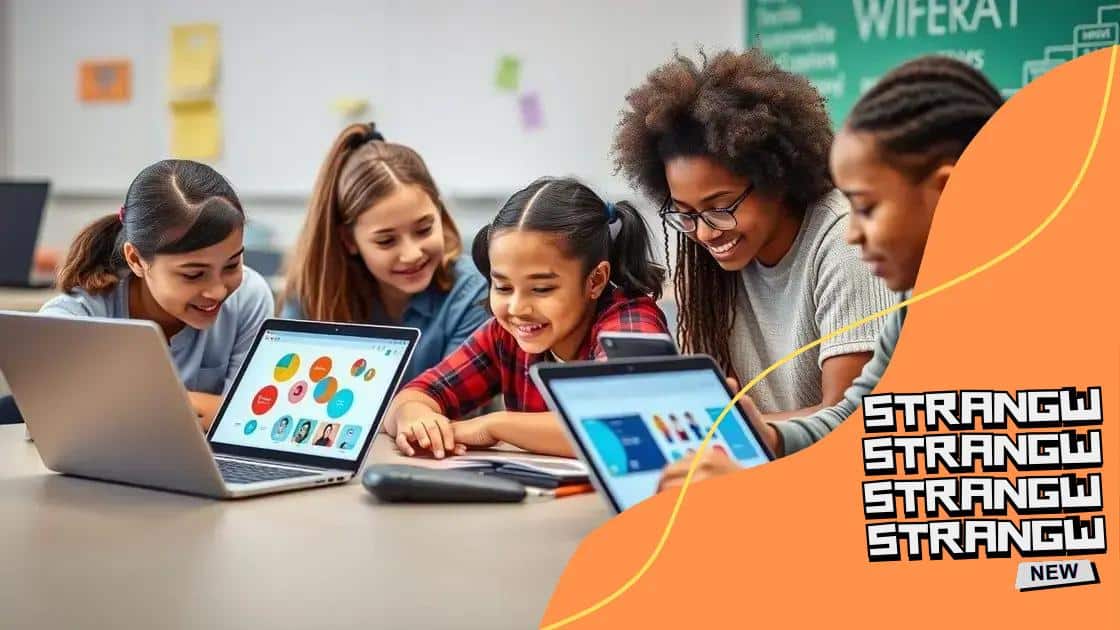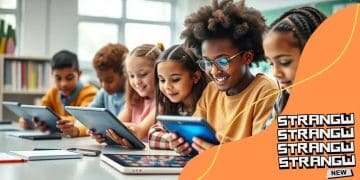Collaborative digital classrooms transforming education

Collaborative digital classrooms leverage technology to enhance engagement, foster teamwork, and prepare students for future challenges by utilizing tools like AI and virtual reality for personalized learning experiences.
Collaborative digital classrooms are changing the way students learn and engage with each other. Have you ever wondered how technology can enhance teamwork and creativity in education? Let’s dive in and explore these innovative learning environments.
Understanding collaborative digital classrooms
Understanding collaborative digital classrooms is essential for educators and students alike. These classrooms harness technology to foster teamwork and creativity among learners. By integrating various digital tools, these environments enable students to engage with one another in innovative ways.
Key Features of Collaborative Digital Classrooms
The concept revolves around several fundamental elements that enhance the learning experience. Here are some features:
- Interactive Learning: Students can participate actively, sharing ideas and collaborating on projects in real-time.
- Accessibility: Digital tools allow for resources and support materials to be available at any time, encouraging self-paced learning.
- Diverse Learning Styles: Collaboration accommodates various learning styles, making it easier for each student to thrive.
- Global Connectivity: Students can connect with peers worldwide, expanding their perspectives and understanding.
As education evolves, collaborative digital classrooms are becoming increasingly popular. Teachers can utilize various platforms that promote communication and teamwork. For instance, using applications like Google Classroom and Microsoft Teams allows seamless collaboration.
When students interact in these digital spaces, they are encouraged to express their thoughts and learn from one another. This peer-to-peer interaction is crucial for developing critical thinking and problem-solving skills.
Benefits of a Collaborative Approach
The advantages of this model are numerous. Firstly, it makes learning more engaging. Students are more likely to participate when using technology that they enjoy. Additionally, collaborative projects help students develop essential skills such as leadership and teamwork.
Furthermore, by working together, students can support each other’s learning. This sense of community enhances their confidence and motivates them to perform better academically. Ultimately, collaborative digital classrooms prepare students for a future where collaboration is key.
Benefits of collaborative digital classrooms
The benefits of collaborative digital classrooms are numerous and impactful. By using technology to enhance learning, students can experience an education that is not only interactive but also relevant to their futures.
Enhanced Engagement
One primary benefit is increased engagement. In these classrooms, students are motivated to participate actively. They enjoy using digital tools that make learning fun. When learning becomes an engaging experience, students are more likely to absorb information.
Stronger Communication Skills
Moreover, collaborative digital classrooms promote stronger communication skills. Students interact with peers and teachers more frequently. This helps them develop their ability to express thoughts clearly. As they share ideas, they learn to listen and respect diverse viewpoints. They build a community that values collaboration.
- Collaborative Projects: Working on group tasks teaches students how to cooperate and contribute to team efforts.
- Peer Feedback: Receiving input from classmates encourages critical thinking.
- Digital Literacy: Students become more comfortable with technology, which is crucial in today’s world.
Additionally, collaborative environments encourage peer-to-peer learning. Students often grasp concepts better when they explain them to others. This approach allows learners to teach and learn simultaneously, strengthening their understanding. As they work together, students develop problem-solving skills that are essential in both academic and real-world situations.
Flexibility and Accessibility
Furthermore, collaborative digital classrooms offer flexibility. Students have access to resources anytime, anywhere. This means they can learn at their pace and revisit materials when needed. Accessibility is a significant advantage, especially for those who may struggle with traditional learning environments.
Ultimately, the benefits of these classrooms shape learners into well-rounded individuals, ready to face future challenges. They gain the skills necessary for success in a connected and fast-paced world.
Tools for effective collaboration

When it comes to tools for effective collaboration, several digital platforms stand out. These tools enhance communication and facilitate teamwork among students in a collaborative digital classroom. By leveraging technology, educators can create engaging learning environments that promote interaction and creativity.
Essential Collaboration Tools
Here are some key tools that foster collaboration:
- Google Workspace: This suite includes tools like Google Docs, Sheets, and Slides, allowing students to work on projects simultaneously and share feedback easily.
- Microsoft Teams: An all-in-one platform where students can chat, share files, and conduct video calls, promoting seamless teamwork in and out of the classroom.
- Trello: A project management tool that helps students organize tasks and track progress on group assignments, ensuring everyone stays on the same page.
- Padlet: An interactive online board where students can share ideas, images, and links, encouraging open discussions and brainstorming sessions.
These tools not only streamline group work but also help students learn from each other. By utilizing various applications, learners can see different perspectives, encourage creativity, and solve problems together.
Benefits of Using Digital Tools
Additionally, integrating these tools into lessons can lead to improved outcomes. As students become familiar with technology, they gain skills that are essential for the future.
For example, using Google Workspace encourages effective communication among team members. When students work together on documents or presentations, they can ask questions and give suggestions in real-time. This immediate feedback boosts understanding and learning retention.
Moreover, these tools promote accountability. With platforms like Trello, students can assign tasks to each other and track who is responsible for what. This clarity helps ensure that all contributions are valued and acknowledged.
Incorporating various digital collaboration tools thus enriches the learning experience, preparing students to thrive in collaborative environments both in school and beyond.
Challenges faced in digital classrooms
The challenges faced in digital classrooms can significantly impact the learning experience. As technology evolves, educators and students encounter various obstacles that can hinder the potential of a collaborative digital environment.
Technical Issues
One major challenge is technical issues. Students may experience connectivity problems, software glitches, or hardware malfunctions. These interruptions can disrupt lessons and lead to frustration. It is crucial for educational institutions to have proper tech support in place to help quickly resolve these issues.
Digital Distractions
Another significant challenge in digital classrooms is digital distractions. With access to the internet, students may find it hard to focus on their work. Social media, games, and other online content can pull their attention away. Teachers need to find ways to keep students engaged and minimize these distractions during lessons.
- Setting Clear Guidelines: Establishing rules for technology use can help students stay focused.
- Interactive Activities: Incorporating interactive tasks can keep students interested and on task.
- Regular Check-Ins: Frequent communication can help teachers understand student needs and adjust their teaching methods.
Moreover, not all students may have equal access to technology or a quiet space for learning. This creates an environment of inequality. It’s essential for schools to provide resources and support to ensure that all students can participate fully in digital classrooms.
Maintaining Student Engagement
In addition to these challenges, maintaining student engagement can be difficult in a virtual setting. Often, students feel less motivation when learning online. Unique strategies are needed to ensure that students feel connected and involved in their learning.
To address this, educators can use gamification. This approach incorporates game-like elements into lessons, making learning more enjoyable. By creating fun and competitive environments, teachers can motivate students to participate actively in their education.
Ultimately, recognizing and addressing these challenges is key. By implementing effective strategies and fostering open communication, schools can enhance the learning experience in digital classrooms.
Future trends in collaborative digital education
The future trends in collaborative digital education promise exciting changes for students and educators alike. As technology evolves, these trends aim to enhance learning experiences and foster deeper collaboration among students.
Increased Use of Artificial Intelligence
One major trend is the increased use of artificial intelligence in education. AI can provide personalized learning experiences for students. By assessing individual needs and learning styles, AI-driven tools can tailor lessons to help each student succeed. This customization can enable teachers to focus on students who need extra help.
Virtual and Augmented Reality
Another emerging trend is the incorporation of virtual and augmented reality into the classroom. These technologies can create immersive learning experiences, allowing students to explore complex concepts in a more engaging way. For example, students can take virtual field trips to historical sites, enhancing their understanding of different cultures and contexts.
- Real-World Applications: Students can practice skills in simulated environments through VR.
- Collaboration Across Distances: AR and VR will make it easier for students in different locations to work together on projects.
- Enhanced Engagement: These tools can motivate students and spark their curiosity about subjects.
Additionally, the rise of learning management systems (LMS) will continue. These platforms streamline communication between students and teachers and provide access to resources in one central location. As technology improves, LMS will become more interactive, enabling engaging activities such as discussions and instant feedback.
Emphasis on Soft Skills Development
Moreover, there will be a greater emphasis on developing soft skills alongside academic knowledge. Collaborative learning environments encourage cooperation, communication, and critical thinking. Schools will focus more on creating opportunities for students to work together, solve problems, and develop leadership skills.
Incorporating project-based learning will also be crucial. This approach allows students to work on real-world challenges, encouraging them to collaborate, think critically, and apply their knowledge practically. As these trends unfold, digital classrooms will continue to adapt, making learning more relevant and effective.
FAQ – Frequently Asked Questions about Collaborative Digital Classrooms
What are collaborative digital classrooms?
Collaborative digital classrooms use technology to enable students to work together on projects, share ideas, and enhance their learning experience.
How can technology improve student engagement in these classrooms?
Technology provides interactive tools and resources that make learning more fun and engaging, keeping students motivated and interested.
What challenges do teachers face in digital classrooms?
Teachers may face challenges like technical issues, student distractions, and ensuring all students have access to technology.
What trends are shaping the future of digital education?
Key trends include the use of artificial intelligence for personalized learning, the integration of virtual and augmented reality, and a focus on developing soft skills.





